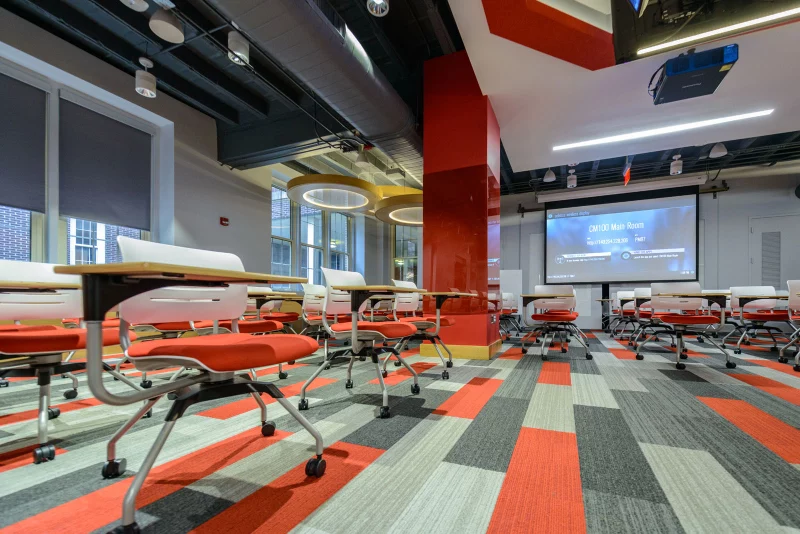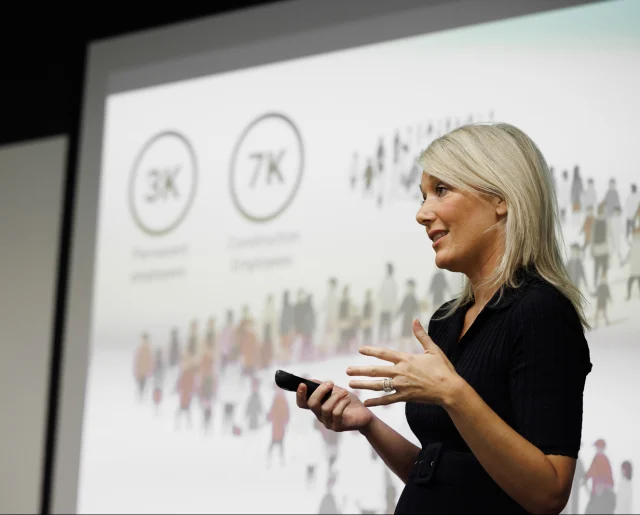The Intel on Intel: The Industry Impact on National Security, Staffing + Supply Chain and How You Can Be Prepared

We sat down with Betsy Goldstein, known for her statewide “Intel on Intel” presentations to learn more about this unprecedented investment in Ohio by Intel. Betsy is recognized throughout Ohio as the unofficial ultimate expert, and enthusiast, on all things Intel project, and progress, related, taking time to share the latest updates and information you need to know for our MA Design followers.
There has never been a project of this size, or magnitude, in the entire state of Ohio’s history.
Never.
And it’s less than 3 years away from being fully functional.
We’re talking, of course, about Intel’s strategic decision to invest more than $20 billion in the construction of two new leading edge chip factories in Ohio. According to their official press release, these factories will allow the company to “boost production to meet demand for advanced semiconductors, power a new generation of innovative products from Intel, and serve the needs of foundry customers.”
Spanning nearly 1,000 acres in Licking County, just outside of Columbus, the “mega-site” can accommodate a total of eight chip factories as well as supporting operations and ecosystem partners.” This announcement is even more triumphant after yesterday’s news that the “CHIPS Act” finally passed – delayed since November – that, according to The Washington Post, will “provide $52 billion in subsidies to domestic semiconductor manufacturers, as well as invest billions in science and technology innovation, in a bid to strengthen the United States’ competitiveness and self-reliance in what is seen as a keystone industry for economic and national security.”
Breaking Down Chips + Their Impact on National Security
What do chips have to do with national security? And, take it back even further, what’s a chip?
We’re glad you asked.
By definition, “chip” is short for microchip which is an incredibly complex, yet incredibly small module that store computer memory or provide logic circuitry for microprocessors.
“Chips” are used in almost every electronic device we use today, including cars, smartphones, gaming consoles, home appliances, medical equipment and more.
And, right now, there’s an international shortage of chips.
Have you noticed the rise of car prices, or the shortage of car rentals? Have you seen how empty the shelves at Best Buy and other brick and mortar stores are?
Forbes noted in a featured article on the international chips shortage that, “Supply chain disruption has grown to a top threat across industries. The chip shortage has brought car production to a standstill, delayed consumer electronics product launches, and impacted companies’ ability to onboard new employees.”
And, there is a clear tie to national security and the chip shortage impact on military defense supplies. One clear example: the military has expressed their deep interest in providing more equipment to Ukraine, which currently isn’t possible given the shortage of defense pieces and parts.
The Center for Strategic + International Studies released a journal on the topic, noting, “All major U.S. defense systems and platforms rely on semiconductors for their performance. Consequently, the erosion of U.S. capabilities in microelectronics is a direct threat to the United States’ ability to defend itself and its allies. Moreover, the U.S. civilian economy is deeply dependent on semiconductor-based platforms for its daily operations. Ensuring U.S. leadership in semiconductor technology and securing the integrity of the value chains that design, manufacture, package, and distribute these chips are perhaps the preeminent economic and national security concerns of the modern era.”
From the Department of Defense, to moms and minivans, the ability to manufacture here not only solves for an international shortage and eliminates crisis, but also puts the power back into our own hands at home.
Hopefully you’ve got some of the excitement sparked inside of you that seeps out of me, and now we can talk about the impacts of Intel and how to best be prepared, especially for those right here in Ohio.
Updates on Progress + Project Status + Key Players
The Intel site officially broke ground last week for the planet’s largest chip manufacturing site that will be open in 2025. Right now, they are officially moving dirt at the facility, getting ready for roads and infrastructure. Intel will hire and train at their other facilities, so, when this facility opens, everyone will be trained and ready to go.
The key players in the progress include OneColumbus and Jobs Ohio, responding to Intel’s proposal to help find land and work with trade unions to help proactively procure talent. The New Albany Company assembled available land, cooperating however they can to continue the progression of the plant and the investment in the greater Columbus community. There has been a lot of bipartisan support and collaboration to make this happen because despite any differences that might drive people apart, the possibilities of this project’s potential and the greater good for all involved is undeniable.
Construction Impact of Intel on Ohio + Beyond
Intel is expecting the need for 7,000 construction and subcontractors on site each day during the peak of building. For reference, the most any Columbus project has ever seen prior to this was 1,500 per day during the recent construction of Lower.Com Field – the new Crew Soccer Stadium.
Plumbers that on a typical basis were being paid $45 an hour are already being paid $70 an hour.
Intel’s investment extends to their dedication to the development of supporting infrastructure, including K-12 schools, fire stations, housing, etc., all of which will need workers and supplies.
The areas of impact that will see the greatest growth include a statewide opportunity, housing, manufacturing, industrial, and education – including higher education, career technical and investing in K-12.
Education Impacts
Intel has made their strategic thought process clear; they want to educate young students today to prepare them to be workforce ready in engineering, technology and opportunities available at the site so they have the fundamentals and the foundation to drive the future of these chip manufacturing sites.
We’ll see partnerships with career technical schools, and engineering schools in higher education throughout the state, looking to grow and groom the new generation of manufacturing engineers.

The average salary has been announced at $130,000, which can sound shocking when thinking of traditional manufacturing plants which is where automation comes into play. Intel has worked through great innovation and harnessing technology to automate the majority of the production process, having robots do the physical work driven by the tech-driven human’s input.
To be best prepared for the educational impacts, following in Intel’s lead and developing relationships with high schools, trades schools and colleges that align with your company’s focus areas is a great way to develop relationships now with those that could be employees in your company’s future next, and potentially, the next generation of leaders.
Population Growth Impacts
With an average salary at $130,000, and an anticipated 2,000+ families moving to the greater Columbus area, this is an opportunity to bring in a well-educated and well-paid population, which, then, impacts everything.
Intel is going to bring in a new type of resident: young, tech folks that we haven’t had in Ohio in this way before. What they’re branding as “The Silicon Heartland” will be an infusion of that lifestyle in what today in Knox County is nothing more than sprawling acres of farmland.
It is a population that can be described as innovative, with a deep appreciation for education – both its impacts personally and professionally.
To best be prepared, and capitalize on this new audience, restaurants and retailers that offer experiential components can anticipate an influx of new consumers, and brands will continue to be challenged to meet the expectations of this new population.
Housing developments and residential complexes can focus on amenities and offerings that cater to these types, considering ways to elevate the “Smart Home”, or work with our team to evaluate ways to differentiate from other competitors.
Housing Growth Impacts
This is my personal biggest priority, especially when you already see the supply being stressed the way it is now it makes me curious – and a little nervous in all honesty – for what’s to come next. But, people don’t plan to fail, they fail to plan – so this will be the key to success in preparing for the housing growth impacts.
Two things to consider:

One: For every 4 people retiring out of the trades, only 1 was coming in.
Companies in the AEC world need to start considering how they can embrace construction technology to help stop some of the labor issues. A great example is our clients at Path Robotics, and their invention of welding robots to solve for the fact that no one wants to be a welder anymore. Now, the robots are able to weld and the humans are able to automate the input – augmented intelligence at its finest.
More, developers can start to partner with architects and contractors early on in scheduling, securing contracts, making sure they have those people lined up.
Communication between architects, developers + construction companies is going to be key. For Architectural Firms + Construction Companies, it is important to communicate costs of changes for labor rates and materials, and stay dedicated to consistently staying updated on that industry-specific information as things inevitably fluctuate.
Two: When you start to see areas of towns displacing a lot of low income people, affordable housing is going to reach a crisis level.
Even “attainable housing” is going to need to stay a key focus – the idea of a place a recent college graduate could live. Without focus, even “attainable housing” will be priced out of budgets, creating a real disparity.
The solution is for innovative developers to continue to move forward with developers, like our incredible partners at Homeport, and for city official incentivize attainable, and affordable, housing, options for all.
Workforce Recruitment + Retention Efforts
Even if you feel your industry is untouched by Intel, think again. There are going to be more opportunities with more pay for all industries throughout the state, even including seemingly unrelated areas like hospitality or retail.
So what can you do to keep your team of top tier performers, and continue to recruit high contributors?
Start preparing now by focusing on recruitment and retention efforts, doing market research on benchmarks for income, hourly rate, etc.
The squeeze is going to happen when there’s a billion dollar project at the airport, hospital, 500M at OSU, on top of the other projects in and around town all happening simultaneously.
Companies have to look at benefits packages, retention packages, how and where they’re recruiting and making sure their employees feel fulfilled and appreciated in a meaningful way.
Some of it too many including expanding your mindset and asking yourself questions like if you are open to hiring a felon? Our partners at Hot Chicken Takeover were innovators in this space, hiring homeless, those that were previously incarcerated, or experienced other barriers to employment – and it turned out to be one of their greatest assets, and admired differentiators.

While there is much to be determined, one thing is clear: the impact of Intel will be a historical moment in the making. It’s an investment that will shape a generation, and build a future beyond what any of us have ever experienced.















